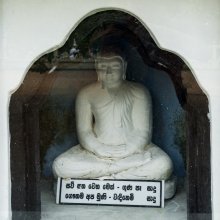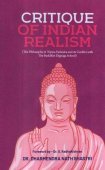Gotama: 12 definitions
Introduction:
Gotama means something in Hinduism, Sanskrit, the history of ancient India. If you want to know the exact meaning, history, etymology or English translation of this term then check out the descriptions on this page. Add your comment or reference to a book if you want to contribute to this summary article.
Images (photo gallery)
In Hinduism
Purana and Itihasa (epic history)
Source: archive.org: Puranic EncyclopediaGotama (गोतम).—A sage named Gotama, son of Rahūgaṇa, is found everywhere in Ṛgveda. The seventyfourth sūkta in the thirteenth anuvāka of the first maṇḍala of Ṛgveda is composed by this sage. There are many other sūktas also in his name. This sage is not the Gautama, husband of Ahalyā, who made Sūkta 58, Anuvaka 11, Maṇḍala 1 of Ṛgveda.
Once this Gotama tired of thirst asked the Maruts for some water. The Maruts took a huge well to his side and poured water into a big pot. (Sūktas 86, 87, Anuvāka 14, Maṇḍala 1, Ṛgveda).
It was Aśvinīdevas who took the well to Gotama. (Sūkta 116, Anuvaka 17, Maṇḍala 1, Ṛgveda).

The Purana (पुराण, purāṇas) refers to Sanskrit literature preserving ancient India’s vast cultural history, including historical legends, religious ceremonies, various arts and sciences. The eighteen mahapuranas total over 400,000 shlokas (metrical couplets) and date to at least several centuries BCE.
India history and geography
Source: Ancient Buddhist Texts: Geography of Early BuddhismGotama (गोतम) is the name of a mountain situated in Majjhimadesa (Middle Country) of ancient India, as recorded in the Pāli Buddhist texts (detailing the geography of ancient India as it was known in to Early Buddhism).—According to the description given in the Apadāna the Gotama mountain seems to be not far off from the Himavanta.

The history of India traces the identification of countries, villages, towns and other regions of India, as well as mythology, zoology, royal dynasties, rulers, tribes, local festivities and traditions and regional languages. Ancient India enjoyed religious freedom and encourages the path of Dharma, a concept common to Buddhism, Hinduism, and Jainism.
Languages of India and abroad
Sanskrit dictionary
Source: DDSA: The practical Sanskrit-English dictionaryGotama (गोतम).—
1) Name of a sage belonging to the family of Aṅgiras, father of Śatānanda and husband of Ahalyā.
2) Name of a sage, the founder of Nyāya philosophy; मुक्तये यः शिलात्वाय शास्त्रमूचे सचेतसाम् । गोतमं तमवेक्ष्यैव (muktaye yaḥ śilātvāya śāstramūce sacetasām | gotamaṃ tamavekṣyaiva) N. 17.75.
Derivable forms: gotamaḥ (गोतमः).
Source: Cologne Digital Sanskrit Dictionaries: Edgerton Buddhist Hybrid Sanskrit DictionaryGotama (गोतम).—MIndic spelling for Gautama, q.v.: Śikṣāsamuccaya 331.11 (here apparently = Gautama 3).
Source: Cologne Digital Sanskrit Dictionaries: Shabda-Sagara Sanskrit-English DictionaryGotama (गोतम).—m.
(-maḥ) The name of a sage belonging to the family of Angiras father of Satananda; also gautama. gobhistamo dhvastaṃ yasya pṛṣodarāditvāt .
Source: Cologne Digital Sanskrit Dictionaries: Benfey Sanskrit-English DictionaryGotama (गोतम).—m. The name of a Ṛṣi, Mahābhārata 13, 4490.
Source: Cologne Digital Sanskrit Dictionaries: Cappeller Sanskrit-English DictionaryGotama (गोतम).—[masculine] the biggest ox; [Name] of [several] men, [plural] their race.
Source: Cologne Digital Sanskrit Dictionaries: Monier-Williams Sanskrit-English Dictionary1) Gotama (गोतम):—[=go-tama] [from go] a m. (go-) (superl.) Name of a Ṛṣi belonging to the family of Aṅgiras with the [patronymic] Rāhū-gaṇa (author of [Ṛg-veda i, 74-93]), [Ṛg-veda; Atharva-veda; Śatapatha-brāhmaṇa i, xi, xiv; ṢaḍvBr.] etc.
2) [v.s. ...] (for gaut) Name of the chief disciple of Mahā-vīra
3) [v.s. ...] of a lawyer (cf. gautama)
4) [v.s. ...] of the founder of the Nyāya [philosophy]
5) [v.s. ...] ‘the largest ox’ and ‘Name of the founder of Nyāya [philosophy]’ [Naiṣadha-carita xvii, 75]
6) [v.s. ...] Name of a son of Karṇika, [Buddhist literature]
7) [v.s. ...] ? [Mahābhārata xiii, 4490] (cf. -dama)
8) [v.s. ...] m. [plural] ([Pāṇini 2-4, 65]) the descendants of the Ṛṣi Gotama, [Ṛg-veda; Āśvalāyana-śrauta-sūtra xii, 10; Lāṭyāyana]
9) [v.s. ...] n. a kind of poison, [Demetrius Galanos’s Lexiko: sanskritikes, anglikes, hellenikes]
10) [=go-tama] b etc. See go, p. 364, col. 2.
Source: Cologne Digital Sanskrit Dictionaries: Yates Sanskrit-English DictionaryGotama (गोतम):—(maḥ) 1. m. The name of a sage.
Source: DDSA: Paia-sadda-mahannavo; a comprehensive Prakrit Hindi dictionary (S)Gotama (गोतम) in the Sanskrit language is related to the Prakrit word: Goyama.
[Sanskrit to German]
Sanskrit, also spelled संस्कृतम् (saṃskṛtam), is an ancient language of India commonly seen as the grandmother of the Indo-European language family (even English!). Closely allied with Prakrit and Pali, Sanskrit is more exhaustive in both grammar and terms and has the most extensive collection of literature in the world, greatly surpassing its sister-languages Greek and Latin.
See also (Relevant definitions)
Starts with: Gotamagaura, Gotamakacetiya, Gotamanvaya, Gotamapriccha, Gotamapricchabalavabodha, Gotamapricchabalavabodhakatha, Gotamastoma, Gotamastomapaddhati, Gotamasvamigita, Gotamasvamin.
Ends with: Alavi Gotama, Gauragotama, Kesiyagotama.
Full-text (+392): Gautama, Gotamanvaya, Gotami, Gautamasa, Gotamagaura, Gotamasvamin, Goyama, Gotamapriccha, Lokaikabandhu, Anviksha, Gotamastoma, Arthantara, Pancavaggiya, Akshapada, Samvargajita, Gotameshvaratirtha, Gauragotama, Gotamiputra, Aparagoyma, Apratighata.
Relevant text
Search found 109 books and stories containing Gotama, Go-tama; (plurals include: Gotamas, tamas). You can also click to the full overview containing English textual excerpts. Below are direct links for the most relevant articles:
Rig Veda (translation and commentary) (by H. H. Wilson)
The Gospel of Buddha (by Paul Carus)
The Great Chronicle of Buddhas (by Ven. Mingun Sayadaw)
Part 1 - The Āṭānāṭiya Paritta < [Chapter 39 - How the Āṭānāṭiya Paritta came to be Taught]
Chapter 10 - Hemavata Sutta (the story of Sātāgiri Deva and Hemavata Deva) < [Volume 2.2]
Biography (23): Vaṅgīsa Mahāthera < [Chapter 43 - Forty-one Arahat-Mahatheras and their Respective Etadagga titles]
Brihadaranyaka Upanishad (by Swāmī Mādhavānanda)
Section II - Description of the Prana < [Chapter II]
Section VII - Yajnavalkya and Uddalaka < [Chapter III]
Section II - The Process of Rebirth < [Chapter VI]
Vinaya Pitaka (3): Khandhaka (by I. B. Horner)
The story of General Sīha < [6. Medicine (Bhesajja)]
The story of Keṇiya the matted-hair ascetic < [6. Medicine (Bhesajja)]
Bihar and Eastern Uttar Pradesh (early history) (by Prakash Narayan)
The Buddha and the Gamanis < [Chapter 4 - Social Process, Structures and Reformations]
The Buddha and the Brahmanas in the Buddhist view < [Chapter 4 - Social Process, Structures and Reformations]
The Buddha and the Paribbajakas < [Chapter 4 - Social Process, Structures and Reformations]
Related products


